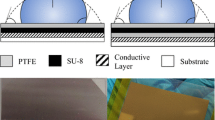Abstract
Printed electronics have recently attracted extensive attention due to their superior productivity to conventional semiconductor fabrication methods. To develop printing devices optimized for printed electronics, numerical studies on ink flows are often necessary, and, therefore, it is critical to provide accurate ink properties for reliable numerical results. However, it is difficult to find such data in literature since inks for printed electronics contains conductive metallic nanoparticles and they are not only non-Newtonian but expensive. Thus, we propose utilizing a microfluidic chip to investigate rheological properties of conductive inks. By using micro particle image velocimeter along with an immersion oil technique, we examine the flow characteristics of two commercial conductive inks containing Ag nanoparticles on microfluidic chips. We found that the ink flows show a stronger shear-thinning behavior as the Ag content increases. Finally, suitable rheological models applicable to numerical simulations for those inks are suggested after comparing the experimental data to frequently used rheological models.








Similar content being viewed by others
References
Ahn SH, Guo LJ (2008) High-speed roll-to-roll nanoimprint lithography on flexible plastic substrates. Adv Mater 20(11):2044–2049. doi:10.1002/adma.200702650
Bird RB, Armstrong RC, Hassager O (1987) Dynamic of polymeric liquids, 2nd edn. Wiley, New York
Carreau PJ, De Kee DCR, Chhabra RP (1997) Rheology of polymeric systems. Hanser, New York
Chu WB, Yang JW, Wang YC, Liu TJ, Tiu C, Guo J (2006) The effect of inorganic particles on slot die coating of poly(vinyl alcohol) solutions. J Colloid Interf Sci 297(1):215–225. doi:10.1016/j.jcis.2005.10.056
Curtin DM, Newport DT, Davies MR (2006) Utilising mu-PIV and pressure measurements to determine the viscosity of a DNA solution in a microchannel. Exp Thermal Fluid Sci 30(8):843–852. doi:10.1016/j.expthermflusci.2006.03.014
Degre G, Joseph P, Tabeling P, Lerouge S, Cloitre M, Ajdari A (2006) Rheology of complex fluids by particle image velocimetry in microchannels. Appl Phys Lett 89(2):024104–0241043. doi:10.1063/1.2221501
Eo SH, Song S, Yoon B, Kim JM (2008) A microfluidic conjugated-polymer sensor chip. Adv Mater 20(9):1690–1694. doi:10.1002/adma.200703007
Girardo S, Cingolani R, Pisignano D (2007) Microfluidic rheology of non-newtonian liquids. Anal Chem 79:5856–5861. doi:10.1021/ac062405t
Huang WX, Lee SH, Sung HJ, Lee TM, Kim DS (2008) Simulation of liquid transfer between separating walls for modeling micro-gravure-offset printing. Int J Heat Fluid Flow 29(5):1436–1446. doi:10.1016/j.ijheatfluidflow.2008.07.002
Izu N, Shen RH, Shin W, Itoh T, Nishibori M, Matsubara I (2009) Preparation of core-shell type cerium oxide/polymer hybrid nanoparticles for ink-jet printing. J Ceramic Soci Jap 117(1366):769–772
Joseph P, Tabeling P (2005) Direct measurement of the apparent slip length. Phys Rev E 71(3):035303(R). doi:10.1103/PhysRevE.71.035303
Krebs FC (2009) Fabrication and processing of polymer solar cells: a review of printing and coating techniques. Sol Energy Mater Sol Cells 93(4):394–412. doi:10.1016/j.solmat.2008.10.004
Lee HH, Chou KS, Huang KC (2005) Inkjet printing of nanosized silver colloids. Nanotechnology 16(10):2436–2441. doi:10.1088/0957-4484/16/10/074
Lindken R, Rossi M, Grosse S, Westerweel J (2009) Micro-particle image velocimetry (mu PIV): recent developments, applications, and guidelines. Lab Chip 9(17):2551–2567. doi:10.1039/b906558j
McDonald JC, Duffy DC, Anderson JR, Chiu DT, Wu HK, Schueller OJA, Whitesides GM (2000) Fabrication of microfluidic systems in poly(dimethylsiloxane). Electrophoresis 21(1):27–40
Meinhart C, Wereley S, Santiago J (1999) PIV measurements of a microchannel flow. Exp Fluids 27(5):414–419
Nguyen NT, Yap YF, Sumargo A (2008) Microfluidic rheometer based on hydrodynamic focusing. Measure Sci Technol 19(8):085405. doi:10.1088/0957-0233/19/8/085405
Prasad P, Reddy AV, Rajesh PK, Ponnambalam P, Prakasan K (2006) Studies on rheology of ceramic inks and spread of ink droplets for direct ceramic ink jet printing. J Mater Process Technol 176(1–3):222–229. doi:10.1016/j.jmatprotec.2006.04.001
Roberts MT, Mohraz A, Christensen KT, Lewis JA (2007) Direct flow visualization of colloidal gels in microfluidic channels. Langmuir 23(17):8726–8731. doi:10.1021/la700562m
Romero OJ, Scriven LE, Carvalho MS (2006) Slot coating of mildly viscoelastic liquids. J Non-Newton Fluid Mech 138(2–3):63–75. doi:10.1016/j.jnnfm.2005.11.010
Santiago JG, Wereley ST, Meinhart CD, Beebe DJ, Adrian RJ (1998) A particle image velocimetry system for microfluidics. Exp Fluids 25(4):316–319
Song S, Eaton JK (2004) Flow structures of a separating, reattaching, and recovering boundary layer for a large range of Reynolds number. Exp Fluids 36(4):642–653. doi:10.1007/s00348-003-0762-2
Tseng WJ, Chen CN (2006) Dispersion and rheology of nickel nanoparticle inks. J Mater Sci 41(4):1213–1219. doi:10.1007/s10853-005-3659-z
Westerweel J (1997) Fundamentals of digital particle image velocimetry. Meas Sci Technol 8(12):1379–1392
Acknowledgments
This work was financially supported by the Seoul R&BD Program (10848).
Author information
Authors and Affiliations
Corresponding author
Rights and permissions
About this article
Cite this article
Jang, YS., Song, S. Rheology of conductive ink flow for printed electronics on a microfluidic chip. Exp Fluids 53, 1–7 (2012). https://doi.org/10.1007/s00348-011-1130-2
Received:
Revised:
Accepted:
Published:
Issue Date:
DOI: https://doi.org/10.1007/s00348-011-1130-2




